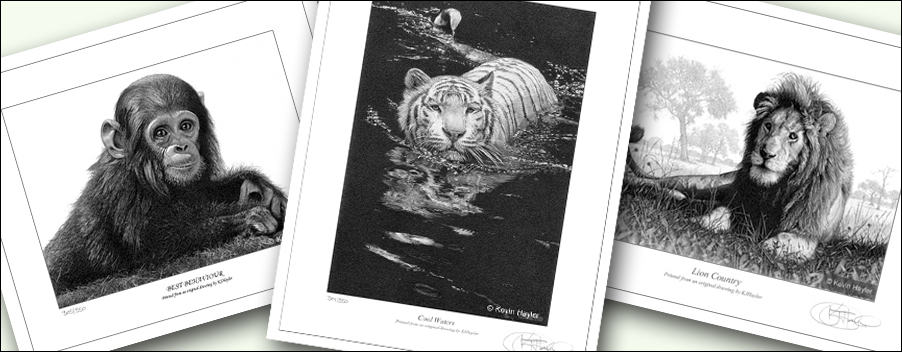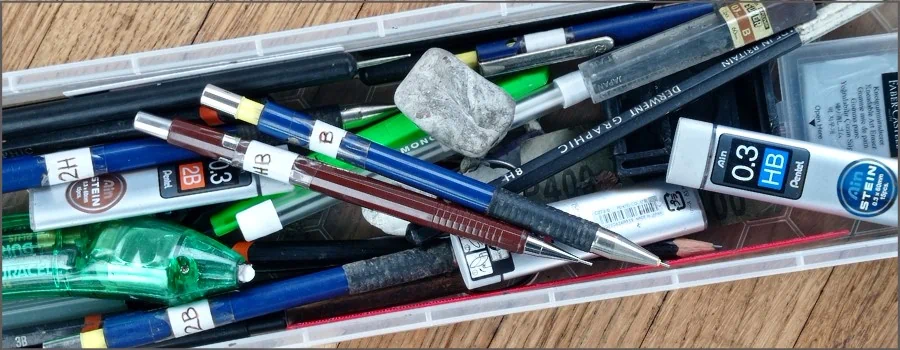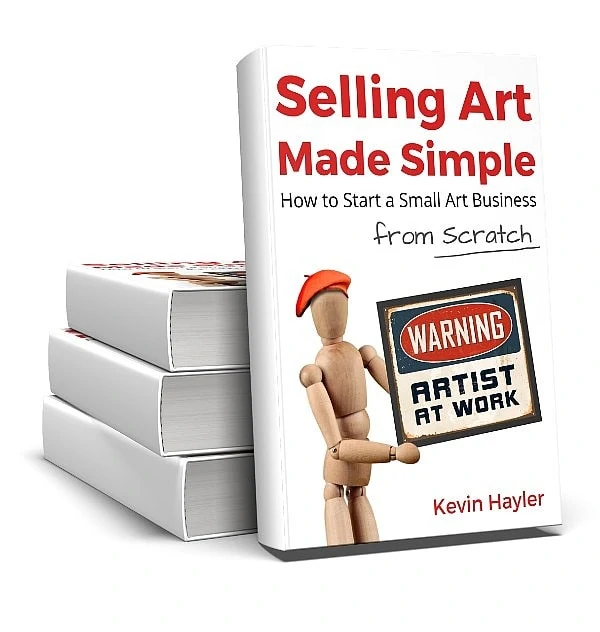Kevin Hayler: Professional Wildlife artist, author, and traveler.
I’ve been selling my limited edition prints for over 20 years and I know there’s confusion in the minds of some people about the term. So instead of taking things for granted, I decided to answer some of the most common questions.
A limited edition print is a reproduction that’s limited to a specified number. Each print is signed and numbered by the artist. Limited editions are created in small quantities and their scarcity increases their value.
This is everything you need to know if you’re thinking about selling limited edition fine art prints.
Let’s start.
The Pros and Cons of Selling Limited Edition Prints
The Advantages of Selling Limited Edition Prints
- You make more money per print than you would by selling regular open editions (unlimited)
- Limited-edition prints are highly collectible and the value of a print can increase as it becomes rarer
- Limited editions are a great way for people to buy your artwork who wouldn’t ordinarily be able to afford the original.
- They can help you make a name for yourself as an artist and establish your brand.
The Disadvantages of Selling Limited Edition Prints
- Limited edition prints require more time and cost more to produce than regular prints.
- Your prints might be too expensive for some potential buyers
- Limited editions might not be so accessible to your fans
- You can’t reissue a limited edition run when they sell out. That limits your potential earnings
- It can be hard to keep track of how many prints you’ve sold. You must keep accurate records.
1. Are Limited Edition Prints More Valuable?
The value of your limited edition art prints is determined by a combination of customer demand and the number of copies in the edition. A highly collectible artist can ask for higher prices and their limited editions may well increase in value as demand increases.
If an artist becomes very popular their prints can sell on the secondary market for substantially more than the original asking price.
I had a customer who remarked that he owned a print, similar in style to some of my own work. As I draw wildlife I knew it was probably drawn by Gary Hodges, a very popular wildlife artist in the UK at the time.
I was right, and as soon as he described it, I knew it was one of his most sought-after prints, a turtle on a beach with ‘tank’ tracks in the sand. He’d bought it in the 90s for very little money.
I advised him to check it out because it was worth about £3000. He returned a few weeks later and thanked me.
Sadly that’s not the story for most of us.
On the whole, limited edition prints are a marketing ploy. They command a higher price because of the in-built scarcity value.
There’s no intrinsic value in a limited edition print if the artist is unknown to the world. The print is worth what the customer is willing to pay for the pleasure it brings them.
The purchase shouldn’t be seen as an investment opportunity. Indeed, my lucky customer, who bought the valuable turtle print, did so because he liked the picture. I don’t know if he sold it. I WOULD!
One last thing worth noting is the higher value attached to the first print in a limited edition. I always ask for more money. In my case, I ask for £50 for print number 1/350.
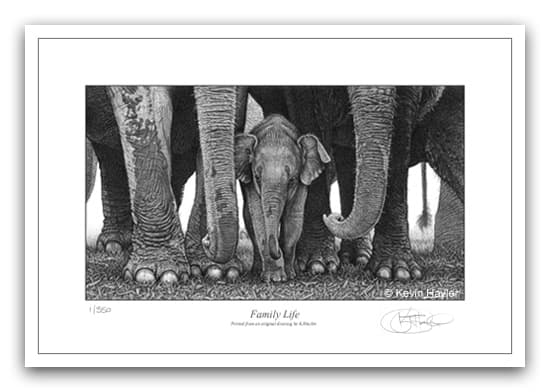
People are very keen to get the first prints. In days gone by there was a logic to that.
The first print was the finest reproduction possible, and as each subsequent print came off the press, the plate wore out, and the print quality slowly diminished.
This no longer holds true. Now it’s more symbolic. People just like the kudos of having the first in the edition. Good to know.
You can also take advantage of the last few prints in an edition. If a popular print is selling well you can increase the price as the edition nears its end.
2. How to Price a Limited Edition Print
Limited edition prints are sold at a premium, but the price of a print is determined by the market you are targeting, the size of your edition, and the cost of production.
So many variables have to be taken into account, that no reliable formulas exist to guide you. You must charge what the market will bear, and that is a matter of trial and error.
Start low and slowly raise the prices until it hurts your sales.
It’s better psychology to start with lower prices and work your way up, than it is to do the reverse. Not only is it deflating to lower your prices, especially if you think the price is fair, but it will also annoy repeat customers who may feel cheated after paying more.
It’s far better to raise your prices and if a regular customer complains, which rarely happens, you can offer a discount as a gesture of goodwill.
This post will open your eyes: This is How to Price Art Prints: Practical Advice for Beginners
I sell my limited edition prints for £20 each (currency converter). That may not seem much, but they are sold next to open editions of the same size and style, that sell for only £6.50 each. There’s a £13.50 price difference.
By and large, I don’t have an affluent customer base. I rely on impulse purchases by tourists in a seasonal market, and consequently, I offer reasonable prices.
If I sold the same prints in a gallery they would command far higher prices but, in all probability, my profits would be no greater, and my turnover would be dreadful.
Add up your true costs of setting up and publishing your prints and you can calculate your bottom line. Anything over that baseline is your profit margin.
Work out how much money you NEED to live on and aim higher.
Calculating how much money you need per day it’s less daunting than plotting a yearly figure and far more achievable.
Don’t restrict yourself to one offer. In addition to selling limited editions, I sell open edition prints and magnets from my market stand, plus most artists take commissions and sell their original artwork too.
You can also consider adding some color wash or unique finishing touches to some prints to increase the print’s value.
The first print of an edition is always worth more to art collectors, and to some extent, this is also true of the last number. I ask more for the last print of a popular edition too. Why not?
I cover pricing and much, much, more, in my guide. If you want to sell your art, you should really check it out.
3. What’s a Good Number for a Limited Edition Print?
Most artists will choose a number somewhere between 200 – 500 prints. Personally, my editions are 350. This range allows for a decent return on investment, and enough scarcity value to ask for a higher price.
Most of my prints, on display, are cheaper open editions, and my limited editions are in a separate portfolio. They are in effect, an ‘upsell’.
I could and would sell my prints for more money if I was in a different setting. Context is everything in the art world.
Most artists face a dilemma when printing their art. A popular print, sold as a limited edition, will limit your profits. I can potentially sell an entire limited edition of 350 prints for a maximum of £7000, give or take.
Selling limited editions improves my daily income but not so in the long term. The same popular print sold as a cheaper open edition will sell for many years to come and, over time, will generate more income.
You don’t know if a print will be a bestseller or not. You can make a calculated guess, but that’s all. You’ll gamble, and at times, get it wrong. I still have some limited editions that will never sell out. They are, in effect, simply padding out my portfolio.
If you can produce originals quickly, that are good enough to print, you can risk making small editions and asking for a higher price. It’s all about your time commitment.
When I was a landscape painter, I was prolific, and I could easily replace a good seller in no time.
Nowadays one drawing can take me a week or more, and successful print sales are essential. Now my decision to make limited editions, or not, is more important. On the whole, I tend to print open editions these days.
This will interest you: How To Sell Landscape Paintings: 13 Ways to Make More Money
4. Can You Reprint a Limited Edition?
It’s not as simple as it should be.
How can you really be sure that the publisher will honor the deal and not reissue the print in another form? You can’t really. Most publishers have integrity, some don’t. No one wants to see their expensive print reappear as a greeting card, but it does happen.
You might find the same image appear as:
- Embossed ‘Gold’ editions on ‘luxury’ paper
- On merchandise,
- As artists proofs,
- In different sizes,
- Or with an artist’s original doodle by the signature.
Imagine paying top dollar for a limited print only to see it republished elsewhere on a mug. Could you challenge it? Probably not. Is it ethical? No, not really. The laws are weak, if indeed they exist at all.
In America, limited edition prints are regulated under state consumer protection laws. California led the way in 1971 and that was followed by the Georgia Print Law in 1986 and widely copied by other States.
In the UK the law doesn’t recognize the term as legally binding.
Another way some artists extend an edition is by hand-tinting the prints. In my mind, this is much more acceptable. Buyers are getting something extra and no one can say the prints aren’t significantly different from each other.
So can you ever reprint a limited edition ethically? I think you can under certain circumstances, but personally, I think it’s a bit of a con.
5. Can You Guarantee That Your Limited Edition is Genuine?
The truth is, you can’t. You are relying on the integrity of all those concerned.
If a limited edition print sells like hotcakes, there are some publishers, and artists, who cannot resist the temptation to ‘extend’ the edition. It can be big money.
Some artists care deeply about their integrity and reputation and will provide a certificate of authenticity to reassure their art buyers. There was also a time when the original printing plates could be destroyed to prevent another print run, but in the digital age, that’s meaningless.
Limited edition prints are likely to be genuine when they’re signed and numbered, especially so if the date and place of purchase is written on the back.
Certificates of authenticity provided by the artist or gallery are also a good sign that the print is genuine, especially if they are supported by a trade build, or respected society.
That’s all you can do. In the end, it comes down to trust. Do you like the seller/artist you are buying from or not?
There is never a guarantee that a print will never be re-issued in another guise, and nothing will not protect you against fraud.
I had one of my limited editions stolen and the image appeared on apparel on a print-on-demand site. I proved provenance and had the seller removed but there is no way I could’ve taken the seller to court for compensation.
In some ways, it’s the wild west out there. Images are easy to steal online and there are plenty of traders who don’t care where images originate as long as they don’t have to pay for them.
6. How Are Limited Edition Prints Made?
Most artists choose between one of two printmaking options for printing high-quality print editions, offset litho prints or giclee prints.
Offset litho prints are made using a single plate, photo-etched with the artwork, upon which ink is applied and pressed against the paper on a printing press. It’s a skilled job and a specialist printer is required to produce acceptable prints.
Giclee prints are digital prints made using archival pigment inks on fine art paper. Most artists choose to outsource the printing but small A3+ inkjet printers are available for home printing.
Until relatively recently offset litho was the preferred method for all fine art printing, and still is for large print runs, but now the vast majority of artists choose Giclee printers for printing limited editions.
They have many advantages, including:
- Printing as many or as few prints as you need,
- Ability to print from home,
- Consistent quality,
- Printing multiple sizes at no extra setup costs,
- Commercial prints can be very big (large format).
Printing is the only viable way for most artists to scale up their business but it’s not without risks and pitfalls. Many things can, and do, go wrong. It can be hard to find a reliable printing company and printing from home is not for everyone.
For the complete guide to printing read this post: How to Make Prints of Your Art – Printing Art Explained in Detail
There is a large investment required upfront, and the maintenance costs are high. Giclee printers are designed to be used regularly, the inks are overpriced, and the maintenance costs can be extortionate.
Many artists choose to pay extra and buy commercial prints.
7. What Is an Artist Proof? (AP)
An artist’s proof is a print sent to the artist for their approval before starting a print run. The artist gets sent a range of prints and they choose the print that most closely matches their original.
The artist’s proof acts as a contractual benchmark. The artist must choose and sign off the best proof, and every print delivered should match the master copy.
The printer keeps a master copy too and agrees to supply the prints to match. That’s the idea, although in my experience it all goes wrong with alarming regularity.
That leaves the redundant artist’s proofs hanging around, so what to do with them all? You might think it’s obvious, you should bin them. A limited edition is supposed to be limited.
Well, the artist’s proofs are generally accepted as a legitimate addition to the initial print run. Publishers take liberties and offer them for sale, and they’re usually sold as another limited edition, neatly packaged, as a nice round number.
Anyone would think that it was contrived and deliberate. When you see 50 artist proofs for sale, you know you’re being taken for a ride.
Only one print is the real proof. That’s the master copy. All the rest are, supposedly, inferior. But of course, they’re not. To the naked eye, they are indistinguishable.
Personally, I don’t offer any proofs for sale, I think it’s disingenuous to sell proofs as anything other than what they really are, and that’s an extension of the existing print run.
8. What Does the Number Mean at the Bottom of a Limited Edition Print?
I have to explain what the number is more often than you might think. I don’t sell in a gallery, I sell on a street market, and many people are genuinely perplexed. They say things such as:
‘I’ve always wondered what the fraction means’
It’s incredible to me, but let’s recap anyway.
So 1/350, is the first print of 350 in total, and so it goes on until you reach the last, 350/350.
The number on the right, after the dash, is the size of the edition. In my case 350 prints. The number on the left is the number of an individual print.
Let’s say you have an edition of 10 only. When it says 5/10, it’s not a fraction, and nor is it the score! It’s the 5th print of 10 in the world. That’s the idea.
The two letters you sometimes see, preceding the numbers, ‘AP’, stand for ‘Artists Proof’.
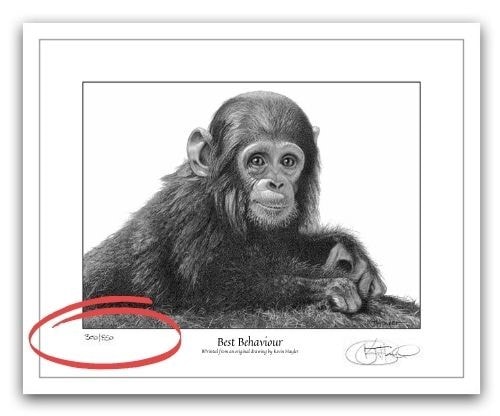
9. What Are Original Prints and How Are They Different?
Original prints are made exclusively by the artist themselves, using their own skills to produce copies one by one, and in short runs. Variations between each print are the norm.
Examples of original prints would be,
- Relief Prints (woodcuts, linocuts)
- Intaglio Prints (etchings, engravings, drypoints)
- Surface Prints (lithographs, monographs)
- Stencil Prints (silkscreen)
The artist makes the masterwork by carving, etching, or drawing onto a surface which is then used to handprint an image. A great deal of knowledge and skill is required.
A short limited edition is produced. The number of prints is determined by the laborious printing process and the gradually diminishing quality of each successive print.
Most commercial limited edition prints, by comparison, are made using offset lithography. These are not described as original prints. The artist makes an original piece of 2D art in any medium and the artwork is photographed or scanned. The picture is saved as high resolution file.
10. Are Limited Edition Prints Always Signed by the Artist?
Yes, it would be strange not to sign each print.
The layout is always the same. The artist writes the number of each print at the bottom left and the signature on the bottom right. This is always done in pencil. Why? probably because ink could be mistaken for being part of the print and not genuine.
The signature is an affirmation that the print is approved by the artist. It’s like quality control. It also adds a personal touch, the artist’s hand, so to speak.
The signature is very important. It took me time to develop the right look, and I can see the pleasure in people’s eyes when I sign a print in front of them. In fact, it’s so important for some people to see me sign it in front of them, I’m often asked to sign it twice!
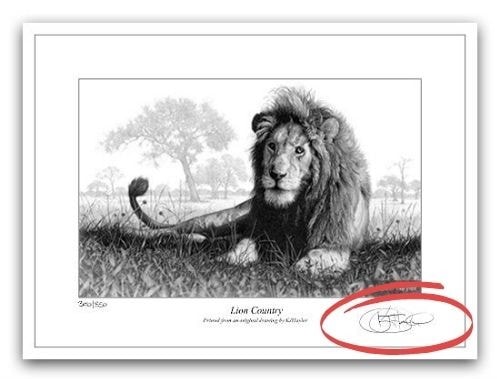
11. How Do Artists Sign and Number Their Limited Edition Prints?
Artists sign and number their limited edition prints in pencil at the bottom of each print and, I can tell you from first-hand experience, there’s an element of skill involved. It’s not easy to sign and number hundreds of prints without making mistakes.
I practiced my ‘arty’ signature well before I started to sell my prints. It had to be aesthetically pleasing and automatic. It takes time for them to develop muscle memory.
I experimented until eventually, I found a way of signing my name that both ‘looked’ the part and matched my style of work. It’s like an instantly recognized brand and provides authenticity and credibility to the piece. It’s important to spend some time getting it right.
The artist’s signature is on the bottom right-hand side of the image and the number is written on the bottom left-hand side.
The numbers must look neat and tidy. If you have dodgy handwriting get used to writing the numbers in a clear and consistent form. You will make a few mistakes anyway and for that reason, I always order more prints than I need as spares. Just in case.
For the best results, I like to use a slightly blunt ‘B’ pencil.
12. Limited Edition Prints vs Open Edition Prints. What’s Best?
Limited edition prints imply exclusivity. Art collectors love them. They feel as if they are closer to the artist. They are not originals but they are the next best thing.
The downside, or one of them anyway, is that they are sold at a higher price point than open edition prints which can make people think twice about buying them.
So if you want to sell more art and make as much money as possible then you might decide to focus on open edition prints (unlimited).
Not only will you have a higher turnover of print sales but you can also sell the same imagery via print-on-demand sites, and/or license your art elsewhere.
What’s the answer? As always it’s to spread your bet. Do as I do and offer some limited prints as ‘special’ and sell the rest as open editions.
What Are Limited Edition Prints? Final Thoughts
There is always more to a seemingly simple subject than you think.
Limited edition prints are a must for most working artists. Prints are the only way to scale your business and at some point, you will have to dip your toe in the water.
Making prints carries a risk.
Some images are good but for some reason never grab the public’s attention. Others, meanwhile, can be mediocre and become a bestseller. All you can do is use your best judgment and get more decisions right than you get wrong.
When it works, the rewards are lucrative.
If you like the way I draw and want to try things for yourself, this is my basic kit
Limited edition prints sell. If you want to sell your art for a living I can show you how to do it in the most practical way. Take a look!
There are plenty more posts like this, have a look at these:
- What Size Art Sells Best? Frames and Apertures – FREE Chart
- What Kind of Art Sells Best? All The Secrets Revealed
- 12 Wildlife Art Bestsellers (Use These Subjects to Make Money)
- 7 Bird Art Bestsellers: Best Wall Art Selling Guide
- 9 Farm Animal Art Bestsellers: Home Decor That Sells!
- Pricing Art For Beginners: Originals, Art Prints, and Formulas
- This Is How Artists Make Passive Income: 7 Practical Side Hustles
- Can You Copy Art and Sell a Painting of a Painting?
- 25 Platforms for Artists to Sell Their Art and Make Money
- How to Negotiate the Price of Your Art Prints and Make Money
Plus find an ONLINE COURSE that suits you.
PIN IT AND SAVE IT
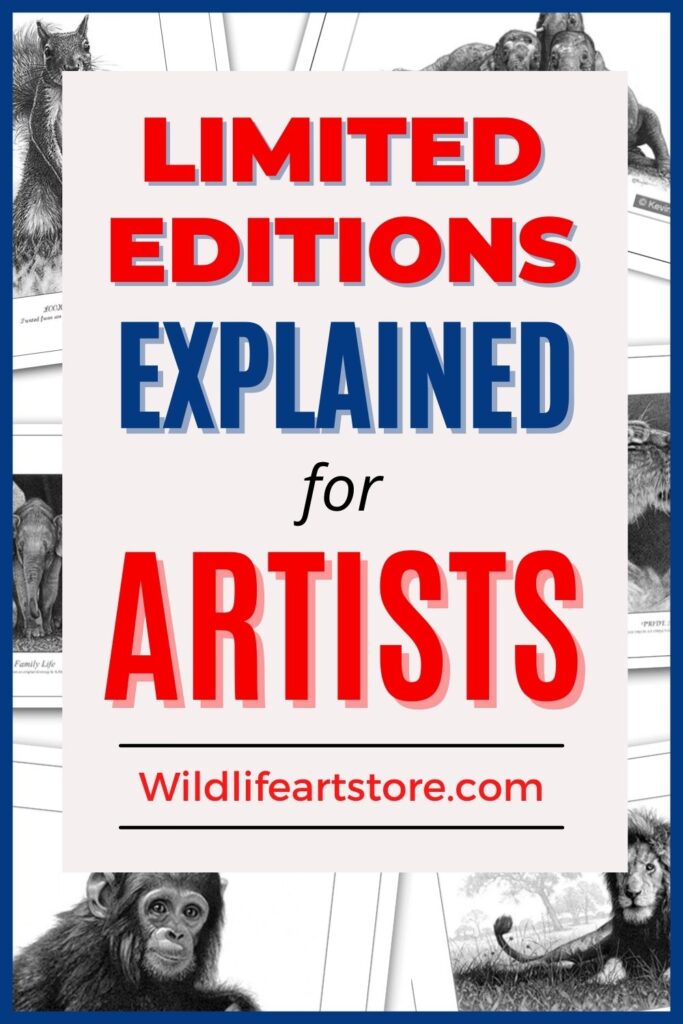

Hi, I’m Kevin Hayler
I’ve been selling my wildlife art and traveling the world for over 20 years, and if that sounds too good to be true, I’ve done it all without social media, art school, or galleries!
I can show you how to do it. You’ll find a wealth of info on my site, about selling art, drawing tips, lifestyle, reviews, travel, my portfolio, and more. Enjoy

